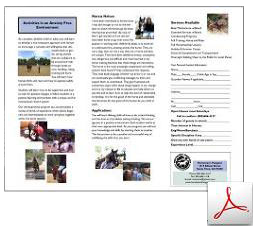 Choosing an appropriate bit
Choosing an appropriate bit
Hi Marcia, I am looking at snaffle bits and curb bits for my new horse. I've been told to use a snaffle on a younger or less experienced horse and a curb bit on horses that are already advanced in their training. How does the action on the horse's mouth differ when using snaffle or curb bits? Is a curb ever appropriate for a horse in the early stages of training?
Marcia's Answer:
A snaffle with young, inexperienced or rough hands can be a problem. Lots don't know that, but the horse will let you know. It's not as simple as saying a snaffle is easier and more beginning in the mouth than a curb. It depends on style, settings and the rider using it. I've had to go back and forth between snaffles and curbs depending on how the horses respond. They seem to need relief from the way a bit functions after awhile and then they need to switch back again or go to a hackamore altogether.
The snaffle bends at the center joint and then it pulls on the most sensitive part of the mouth, their bars. You can see blood drawn on those bars with a hard pull. It can also put pressure on the roof of the mouth from the joint unless they tuck their nose down-and-in. My school horses get perturbed after awhile and will pull and pull the reins out of young hands because they are tired of being yanked around by the bars of their mouths. I'll put a curb on and they'll be fine with a nice loose fitting chin strap so that the action is minimal on it and it's a huge relief for them to no longer have the bars yanked around on.
The curb action works very different. The curve in the bar of the bit is tongue relief not torture. As the reins pull back and the shanks are pulled back, the bit lays down on the tongue applying pressure down on it and the horses can suck their tongue up into the curve. Kind of like people that roll their tongue but in reverse. That's the reason for that. A straight bar across would just apply downward pressure straight across it. As the horse tucks their nose down-and-in that bar is lined up flat at the roof and with a gentle curve and loose chin strap it is not torture on it. The chin strap underneath is what determines the amount of pressure. The more loose fitting that is or if it is not there at all, the shanks just pull back with no pressure anywhere except a straight back pull of the metal in the mouth but it doesn't do anything mechanically. I'll fit those chains or straps loose enough to get a little action but not much when I'm dealing with novices. If I have a rider that is good with their hands I'll set the strap to just enough to have them respond gently but not with any kind of jerky response. I check it when I put it on and draw back on the shanks to see how gentle the setting is. A loose chain curb is far less pressure than a snaffle.
The biggest problem with a curb is removing the bridle. If one allows the headstall to come off of the ears and fall down below the bit and the horse lifts their head in an attempt to dump the bit without opening their mouth while it is down and the person pulls the head stall off from below them while their head is in the air...their chin will get trapped between the chin strap the bit still inside. They end up with their nose popping upwards with the bit still in their mouth and the bridle hanging down and you can't reach them and they get scared or the bridle is yanked off from that position and it's a big problem with the horse.
I teach every single horse I work with to the lower their head to dip their head down to the ground for their halter AND bridle, especially a curb bit bridle so they don't get trapped in that one spot of removal. That one scares me and I won't let a novice remove a curb bridle to avoid that until I have sufficiently taught them how to remove it correctly. I hope this is helpful.
Marcia Nelson
Santa Ynez, CA
www.horsemanshangout.com
(805) 448-5724


